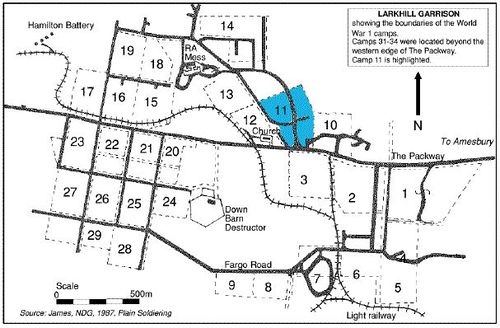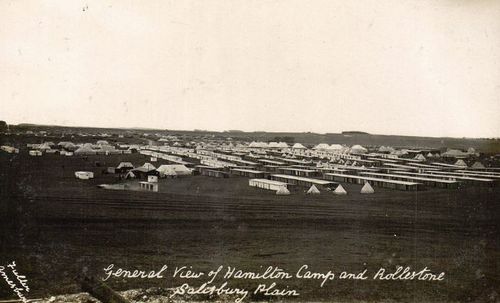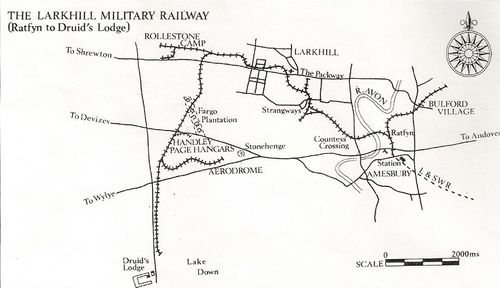Rollestone
From Our Contribution
 Camps in immediate area - No 17 would be Rollestone camp | |
 General view of Hamilton and Rollestone camps | |
 Larkhill Military Railway showing camp locations | |
Remarks
The military camp is 2.9 km to the northeast of the township on the B3086 from Shrewton to Larkhill.
Military usage of land to the northeast of Rollestone began in the early 20th century, as artillery firing ranges which were later used by the Royal School of Artillery at Larkhill Camp. Rollestone Camp was established in 1916 by the Royal Flying Corps for observation balloon training. Around this time the Amesbury and Military Camp Light Railway was extended from Larkhill to Rollestone and beyond; this extension remained in use until about 1923. Balloon-related usage of Rollestone Camp continued until 1939 when the site became a Royal Air Force Anti-Gas School, which closed in 1945. For several months in 1980–81 the camp was used as a temporary prison (HMP Rollestone Camp) during industrial action by prison officers. The camp continues in use as part of the Salisbury Plain Training Area.
During WW1 a Military Light Railway connected Larkhill to the London and South-western Railway spur, at Amesbury Station, crossed the Packway and terminated at Rollestone Camp, with a spur to the site of the original Fargo ammunition dump. The course of the light railway’s permanent way, though pulled up in 1935, can be traced by a line of apple trees that, it is said, have grown from the seeds of apples thrown out by troops on passing trains.
The welfare buildings, on the camp, nearer to the Garrison Church than today’s shops, comprised of:
- Bollen’s Fruit Stores
- Vallers & Co, newsagents
- Sergeant’s Empire Stores and Restaurant (See photo below)
- the YMCA
- The Salvation Army
- the Military Cinema, and the
- 1200 bed Fargo Hospital, built in 1915, north of Fargo plantation.
Soldiers who passed this way
At various times the 5th, 6th, and 7th Training Battalions associated with the 2nd Division were located at Rollestone. Also the 4th, 12th and 13th Training Battalions associated with the 4th Division were also based here.
1916
- Gordon Edgar (George) Bennett 15 May - 8 Sep 1916 - 7th Training Battalion
- Joseph Charles Joshua Farnell 15 May - 24 Sep 1916 - 7th Training Battalion
- Edward Armstrong 12 Jun - 14 Sep 1916 - 7th Training Battalion
- Gordon Vidgen Cross ?? Aug - 21 Sep 1916 - 4th Training Battalion
- William Barge 21 Sep 1916 - 25 Feb 1917 - 7th Training Battalion
- William Francis Cohn 26 Sep - 18 Nov 1916 - 4th Training Battalion
- Frederick Hobbs 3 - 20 Dec 1916 - 7th Training Battalion
- Frederick Hobbs 4 - 20 Dec 1916 - 4th Training Battalion
- Charles Fancote 12 Dec 1916 - 28 May 1917 - 4th Training Battalion - 2nd Convalescent Depot
- Claude Robert Marsh 13 Dec 1916 - 7 Feb 1917 - 4th Training Battalion
- Joseph Charles Joshua Farnell 14 Dec 1916 - 24 Sep 1917 - 7th Training Battalion
- Arthur James Allen 28 Dec 1916 - 7 Feb 1917 - 7th Training Battalion
1917
- George Henry Aspinall 11 Jan - 27 Feb 1917 - 4th Training Battalion
- Hubert Maitland Armstrong MM 11 Jan - 14 Apr 1917 - 13th Training Battalion
- Henry (Harry) Butcher 17 Feb - 29 Apr 1917 - 7th Training Battalion
- David Forbes Abernethy 3 Mar - 13 Jun 1917 - 7th Training Battalion
- Albert William Barratt 3 Mar - 13 Jun 1917 - 7th Training Battalion
- Stephen Gittins 28 Mar - 7 Oct 1917 - 7th Training Battalion
1918